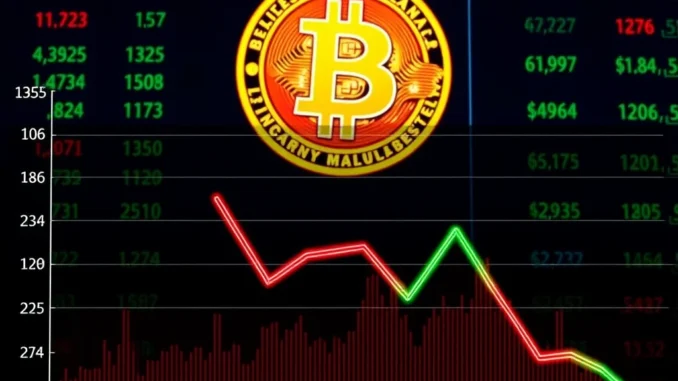
Hold onto your hats, crypto enthusiasts! The U.S. Spot Bitcoin ETFs market just experienced a notable shift. After a period of inflows, we’re seeing a change in momentum. Let’s break down the latest figures and understand what’s driving these movements in the ever-dynamic world of digital assets. Are these Bitcoin ETF Outflows a temporary blip or a sign of a larger trend? Let’s investigate.
What’s Happening with Bitcoin ETF Outflows?
On March 14th, U.S. Spot Bitcoin ETFs collectively witnessed a net outflow of $59.2 million. This marks the second consecutive day of net outflows, according to data from Farside Investors. While the overall ETF market is still relatively new, these fluctuations are crucial to observe as they can indicate investor sentiment and market direction.
Here’s a quick rundown of how individual ETFs performed on March 14th:
- Net Outflows: $59.2 million across all U.S. Spot Bitcoin ETFs
- Largest Outflow: BlackRock’s IBIT – $96.2 million
- Significant Inflows:
- Bitwise’s BITB: $23 million
- Fidelity’s FBTC: $9.2 million
- VanEck’s HODL: $4.8 million
- No Significant Change: Remaining ETFs reported minimal changes in holdings.
To visualize this, consider the following table:
| Bitcoin ETF | Net Flow (March 14) |
|---|---|
| BlackRock’s IBIT | -$96.2 million |
| Bitwise’s BITB | +$23 million |
| Fidelity’s FBTC | +$9.2 million |
| VanEck’s HODL | +$4.8 million |
| Other ETFs | No Significant Change |
| Total Net Outflow | -$59.2 million |
BlackRock IBIT Leading the Outflow: What Does It Mean for Crypto Investment?
The fact that BlackRock’s IBIT, a major player in the ETF space, experienced the largest outflow is particularly noteworthy. IBIT has been a dominant force in attracting inflows since the launch of Spot Bitcoin ETFs in the US. A significant outflow from such a prominent ETF can sometimes signal a shift in institutional sentiment or broader market adjustments. However, it’s important to remember that daily fluctuations are normal, and we need to observe trends over a longer period to draw definitive conclusions about the direction of crypto investment.
Potential Factors Behind the Outflows:
- Profit Taking: After a period of price appreciation in Bitcoin and strong ETF inflows, some investors might be taking profits.
- Market Volatility: The cryptocurrency market is known for its volatility. Uncertainty or price corrections can trigger outflows as investors seek to reduce risk temporarily.
- Macroeconomic Factors: Broader economic conditions, interest rate changes, or geopolitical events can influence investor behavior across all asset classes, including Bitcoin ETFs.
- Rotation into Other Assets: Investors might be reallocating capital to other asset classes or investment opportunities, leading to temporary outflows from Bitcoin ETFs.
Spot Bitcoin ETFs Still Seeing Inflows Elsewhere: A Mixed Bag?
Interestingly, while IBIT saw significant Bitcoin ETF Outflows, other ETFs like Bitwise’s BITB, Fidelity’s FBTC, and VanEck’s HODL continued to attract inflows. This suggests a nuanced picture rather than a uniform exodus from Spot Bitcoin ETFs. It could indicate that investors are still interested in gaining exposure to Bitcoin through ETFs, but perhaps are shifting preferences or diversifying across different providers. The continued inflows into some ETFs also highlight the ongoing demand for regulated and accessible Bitcoin investment vehicles.
Navigating ETF Market Trends: Actionable Insights for Investors
So, what should investors make of these ETF market trends?
- Don’t Panic Sell: Daily outflows are part of the market dynamics. Avoid making impulsive decisions based on short-term fluctuations.
- Look at the Bigger Picture: Analyze trends over weeks and months rather than focusing solely on daily data.
- Diversify Your Portfolio: Bitcoin ETFs can be part of a diversified portfolio, but it’s crucial to manage risk and not put all eggs in one basket.
- Stay Informed: Keep track of market news, ETF flow data, and macroeconomic developments that can influence crypto markets.
- Consider Long-Term Perspective: Bitcoin and cryptocurrencies are still relatively new asset classes. A long-term investment horizon can help weather short-term volatility.
Conclusion: Bitcoin ETF Outflows – A Temporary Dip or a Turning Tide?
The $59.2 million net outflow from U.S. Spot Bitcoin ETFs on March 14th is a data point worth noting. While the outflows from BlackRock’s IBIT are significant, the continued inflows into other ETFs suggest that investor interest in Bitcoin ETFs remains. The crypto market is inherently volatile, and short-term fluctuations are to be expected. For investors, the key is to maintain a balanced perspective, stay informed, and focus on long-term investment strategies rather than reacting to daily noise. The evolution of the Bitcoin ETF market is still unfolding, and these early stages are marked by both exciting growth and inevitable adjustments.



